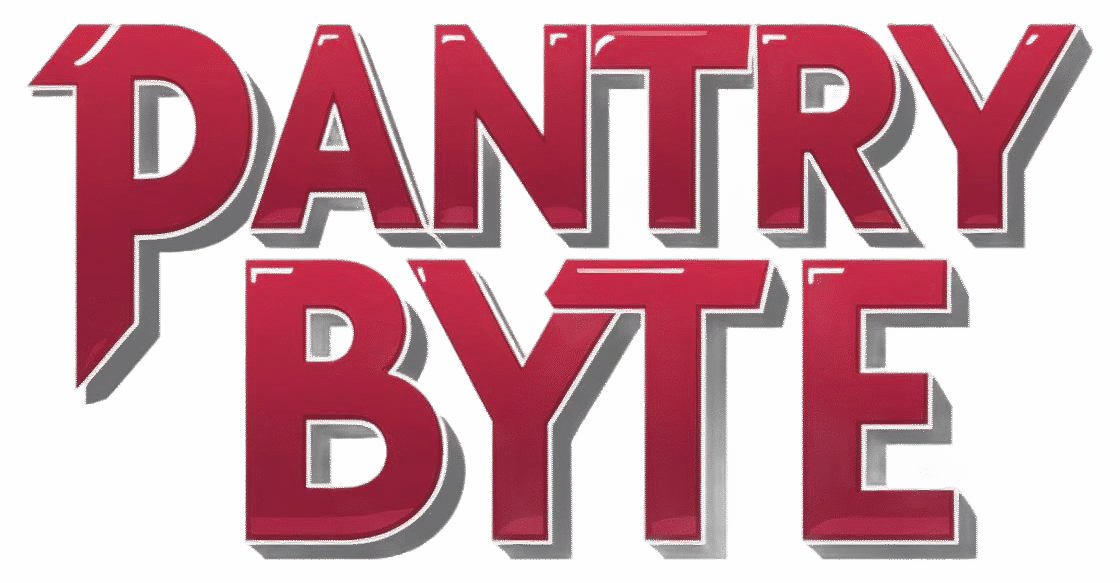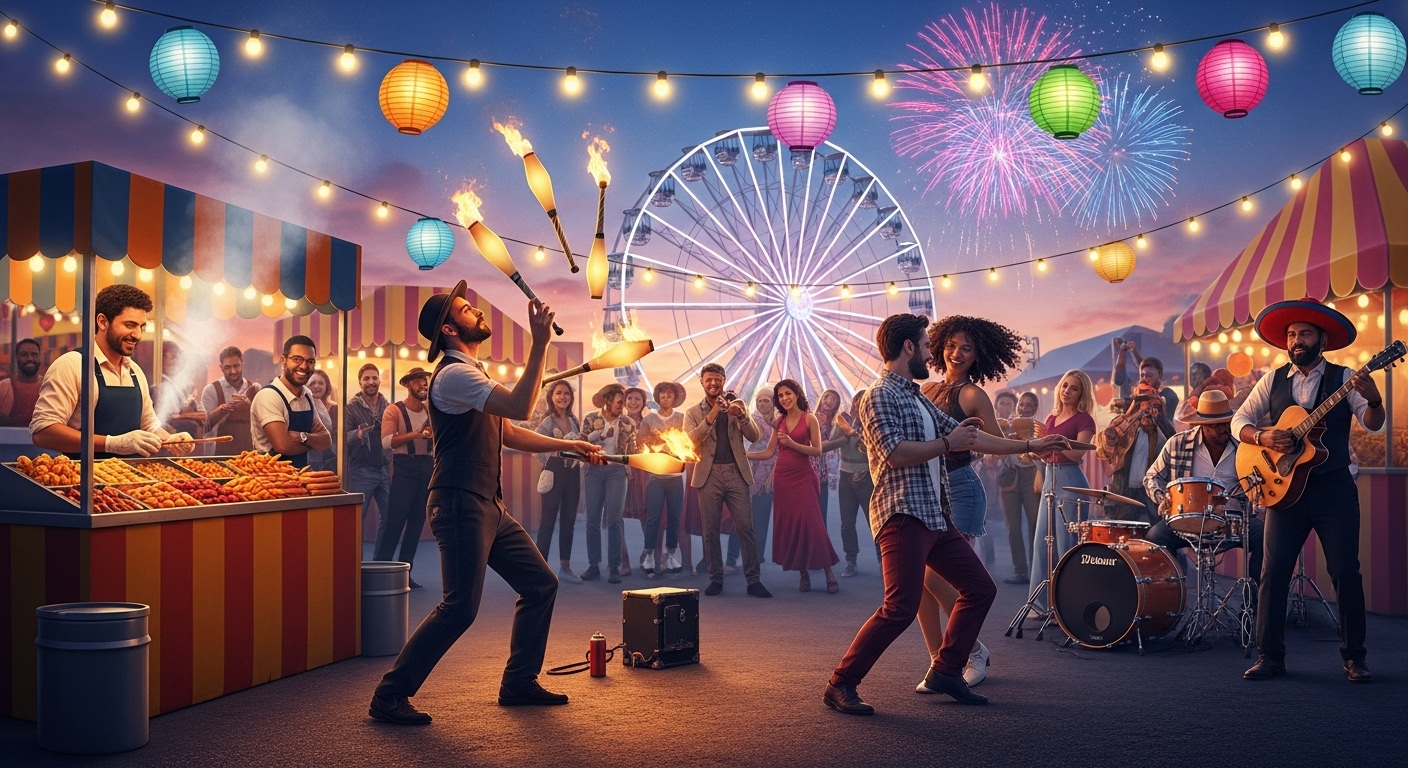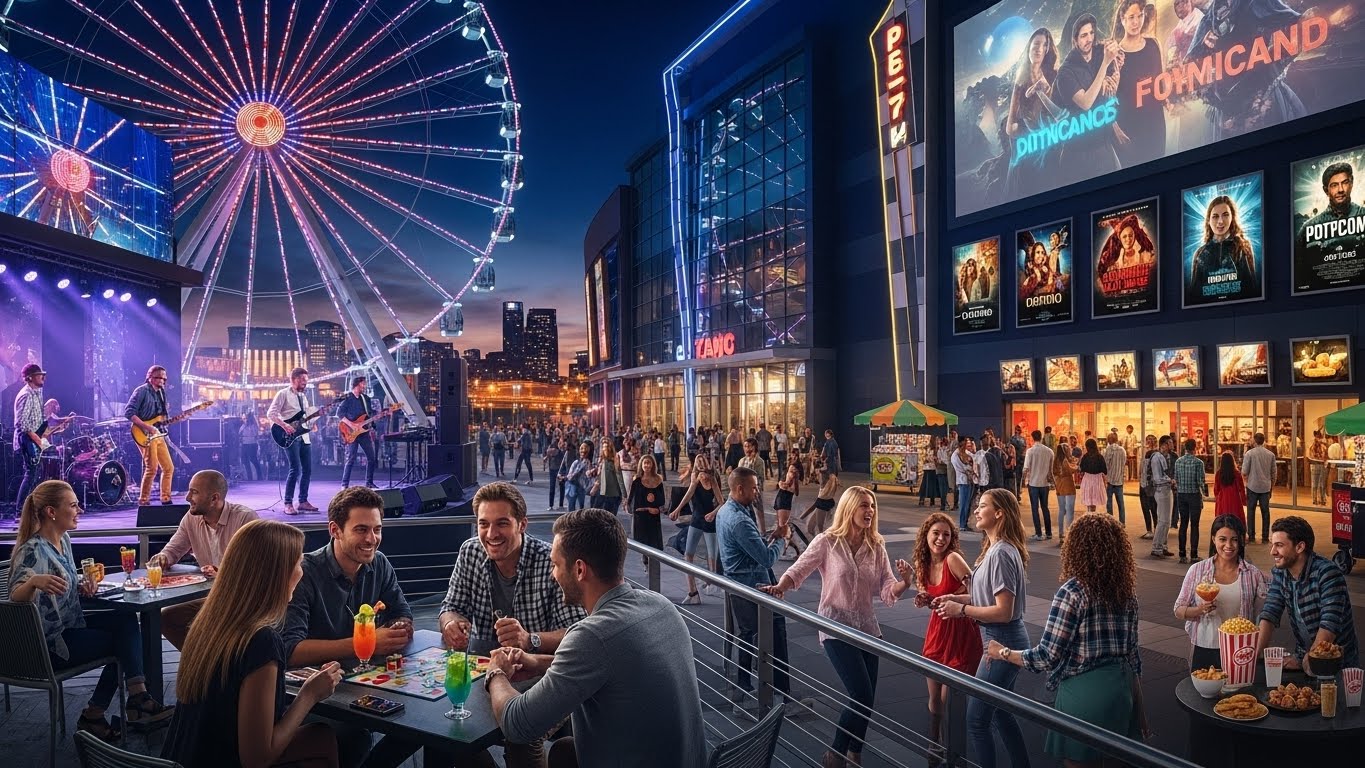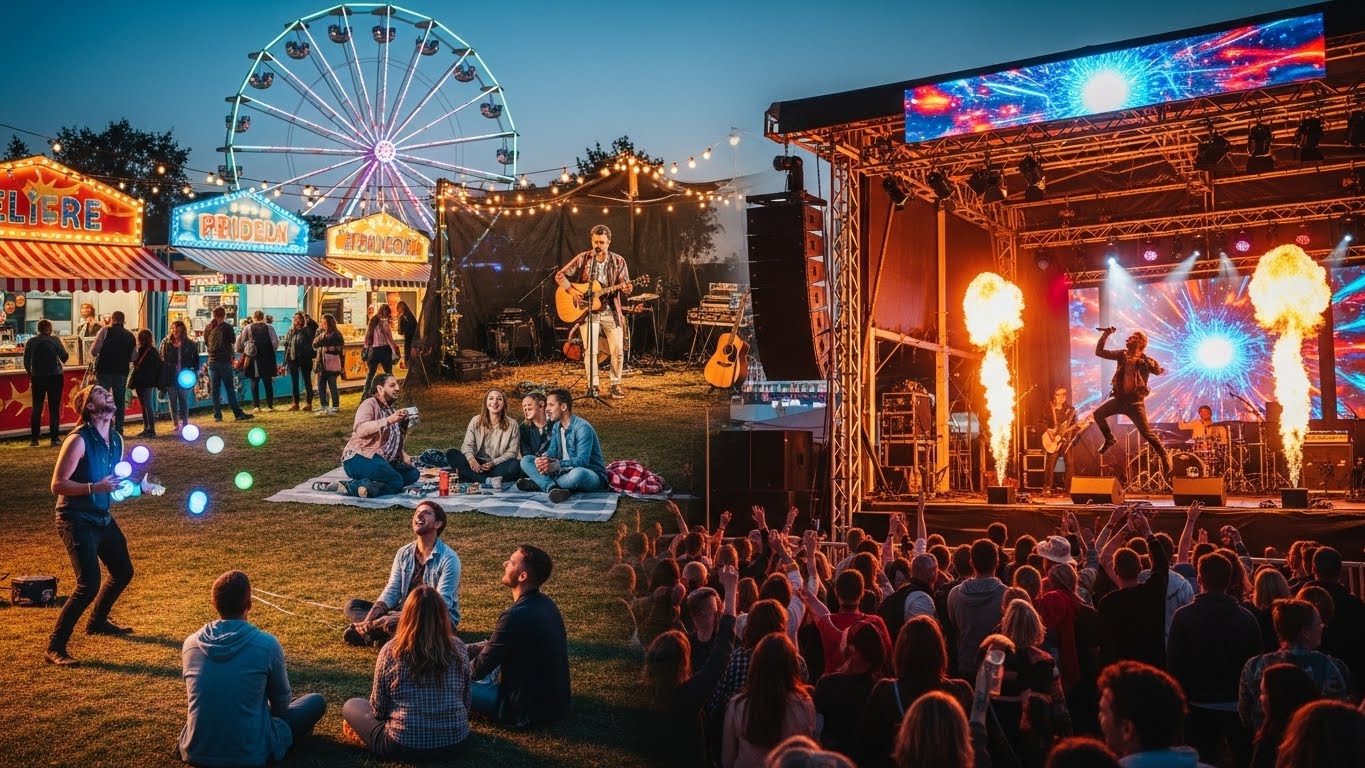Music festivals have been a significant part of cultural expression for decades, bringing together communities, fans, and artists in shared experiences of sound, rhythm, and celebration. From small gatherings of music lovers to massive global events attracting hundreds of thousands, music festivals have evolved dramatically in scale, style, and cultural impact. They are no longer merely concerts; they are immersive experiences that combine music, art, food, technology, and social interaction.
This blog post explores the evolution of music festivals, tracing their history, examining their cultural and social significance, analyzing trends in modern festivals, and highlighting their global impact. Understanding this evolution provides insight into how music festivals have become a cornerstone of entertainment and cultural identity worldwide.
The Early Roots of Music Festivals
The concept of celebrating music in a communal setting is not new. Ancient societies often held gatherings for religious ceremonies, seasonal festivals, and community celebrations where music played a central role. These early events were localized, often connected to cultural rituals or spiritual observances, and involved live performances using traditional instruments.
In Europe, music festivals began to formalize in the 19th century with classical music events. For example, the Bayreuth Festival in Germany, established in 1876, celebrated the works of composer Richard Wagner and attracted audiences from across the continent. These early festivals emphasized high art, formal settings, and curated performances, laying the groundwork for modern festival structures.
Meanwhile, folk festivals began emerging in rural areas, celebrating regional music, dance, and traditions. These events fostered cultural preservation, community identity, and the sharing of music across generations. The combination of formal classical festivals and informal folk gatherings represents the dual roots of modern music festivals: a blend of high art and communal celebration.
The Rise of Popular Music Festivals
The 20th century marked a significant shift in music festivals with the rise of popular music genres such as rock, jazz, and electronic music. These festivals began to target younger audiences and embraced more informal, open-air settings.
Jazz Festivals
One of the earliest examples of modern popular music festivals was the Newport Jazz Festival in the United States, which began in 1954. The festival showcased jazz legends in an outdoor setting, drawing large crowds and inspiring similar events across the country. Jazz festivals highlighted the appeal of live improvisation, audience interaction, and cultural fusion, influencing subsequent festival formats.
Rock Festivals
The 1960s and 1970s brought the iconic era of rock music festivals. Events like Woodstock in 1969 became cultural landmarks, symbolizing freedom, peace, and countercultural movements. Woodstock drew over 400,000 attendees and featured legendary performances that became defining moments in music history.
Rock festivals emphasized communal experience, outdoor settings, and multi-day lineups. They were often associated with social change, political expression, and youth culture, making them more than just entertainment—they became social phenomena.
Folk and Blues Festivals
Folk and blues festivals also gained prominence during this period. Events such as the Newport Folk Festival, which introduced artists like Bob Dylan, celebrated musical storytelling, cultural heritage, and artistic authenticity. These festivals blended performance with education and community engagement, adding depth to the festival experience.
Technological Advancements and Festival Production
As music festivals grew in scale and popularity, technological advancements transformed how they were produced, experienced, and broadcast. Sound systems, lighting rigs, and stage design innovations allowed for more elaborate and immersive performances.
Sound and Stage Design
Large-scale festivals required powerful sound systems to reach massive audiences while maintaining audio quality. Innovations in speaker technology, amplification, and acoustics enabled festivals to accommodate tens of thousands of attendees without compromising sound clarity. Advanced stage design and visual effects created theatrical performances that elevated live music into a multisensory experience.
Live Broadcasting
The rise of television and later internet streaming expanded festival reach. Iconic performances were broadcast to millions of viewers worldwide, transforming local festivals into global cultural events. Broadcasting also allowed fans unable to attend in person to experience the festival atmosphere, increasing accessibility and influence.
Ticketing and Management Systems
Technological developments in ticketing, online registration, and crowd management improved accessibility and safety. Early festivals often faced logistical challenges with massive crowds, but digital tools helped streamline entry, reduce wait times, and enhance attendee experiences.
Globalization and Cultural Diversity
Modern music festivals have become global phenomena, reflecting diverse cultures, genres, and artistic expressions. The internationalization of festivals has broadened their appeal and created cross-cultural experiences.
Europe
Europe hosts a variety of festivals catering to multiple genres. Glastonbury Festival in the United Kingdom, with its eclectic lineup and cultural attractions, has become one of the largest and most celebrated festivals in the world. Festivals across Europe, from electronic music events in Germany to classical music celebrations in Austria, showcase the region’s cultural richness and innovation.
North America
North America is home to festivals such as Coachella, Lollapalooza, and Bonnaroo, which combine music, art, and fashion in immersive experiences. These festivals emphasize diversity in music genres, visual arts, and lifestyle branding, appealing to a broad demographic and fostering cultural trends.
Asia
In Asia, music festivals have grown rapidly, reflecting the region’s vibrant music scene and expanding youth culture. Festivals in Japan, South Korea, and India blend local music traditions with international acts, creating unique experiences that highlight cultural fusion.
Latin America and Africa
Festivals in Latin America, such as Rock in Rio, and in Africa, such as the Cape Town International Jazz Festival, celebrate regional music, dance, and community while attracting global audiences. These events illustrate how music festivals serve as cultural ambassadors, promoting local identity and tourism simultaneously.
The Rise of Niche and Genre-Specific Festivals
As music festivals evolved, organizers began catering to niche audiences and specific genres. This trend reflects the growing diversity of musical tastes and the desire for specialized experiences.
Electronic Dance Music Festivals
EDM festivals such as Tomorrowland in Belgium and Ultra Music Festival in Miami have become iconic for their immersive production, vibrant visuals, and community-driven experiences. EDM festivals emphasize high-energy performances, elaborate stage design, and interactive technology, making them some of the most visually spectacular music events worldwide.
Folk and Indie Festivals
Folk and indie music festivals, including the Newport Folk Festival and Iceland Airwaves, focus on artistic authenticity, storytelling, and intimate performances. These festivals often promote cultural preservation, artistic discovery, and community engagement, attracting dedicated audiences who value musical exploration.
Classical and Jazz Festivals
Specialized classical and jazz festivals maintain a focus on musical excellence and cultural heritage. Events like the Salzburg Festival or Montreux Jazz Festival blend tradition with innovation, drawing both purist audiences and curious newcomers.
Experiential and Immersive Elements
Modern music festivals go beyond concerts, offering attendees immersive experiences that engage multiple senses. These elements transform festivals into cultural phenomena rather than simple music events.
Art Installations and Visual Design
Many festivals integrate large-scale art installations, interactive exhibits, and visual storytelling to enhance the attendee experience. These installations encourage exploration, creativity, and photo-worthy moments, contributing to the festival’s atmosphere and cultural significance.
Culinary and Lifestyle Experiences
Food, beverages, and lifestyle offerings have become integral to festival culture. Gourmet food trucks, local cuisine, and wellness areas add layers of enjoyment and comfort, appealing to diverse audiences and extending the duration of engagement.
Workshops and Education
Workshops, panels, and masterclasses offer educational opportunities alongside entertainment. Attendees can learn about music production, environmental sustainability, or cultural traditions, enhancing their festival experience beyond passive consumption.
Economic and Social Impact
Music festivals have significant economic and social implications, affecting local communities, tourism, and cultural identity.
Tourism and Local Economies
Festivals attract domestic and international visitors, boosting hospitality, transportation, and retail sectors. Cities hosting large festivals often experience significant economic benefits, including job creation and increased tourism revenue.
Community Engagement
Many festivals collaborate with local communities, offering platforms for artists, promoting cultural heritage, and supporting social initiatives. These events can strengthen civic pride and foster cultural exchange.
Cultural Diplomacy
International festivals serve as platforms for cultural diplomacy, showcasing national music, art, and traditions to global audiences. They promote understanding, collaboration, and global connectivity through the universal language of music.
Challenges and Adaptations
Despite their popularity, music festivals face challenges that require adaptation and innovation.
Environmental Concerns
Large festivals often generate significant environmental impact, including waste, energy consumption, and carbon emissions. Organizers are increasingly adopting sustainable practices, such as recycling programs, renewable energy use, and eco-friendly infrastructure.
Safety and Security
Crowd management, emergency response, and health regulations are critical for festival safety. Modern festivals invest in security personnel, medical facilities, and real-time monitoring to protect attendees and performers.
Technological Integration
The digital era demands integration of technology for ticketing, cashless payments, live streaming, and social media engagement. Festivals that embrace technology enhance convenience, accessibility, and global reach.
Adaptation to Global Events
Global events, such as pandemics, have forced festivals to rethink formats. Virtual festivals, live streams, and hybrid events have emerged as innovative solutions, ensuring continuity and accessibility despite physical limitations.
The Future of Music Festivals
The future of music festivals will likely continue to emphasize immersive experiences, cultural diversity, and sustainability. Attendees increasingly seek personalized experiences, technology-driven interaction, and creative engagement beyond music alone.
Virtual and augmented reality may further transform festival experiences, allowing global audiences to participate in interactive digital environments. Additionally, sustainable practices and social responsibility will shape the identity and operation of future festivals, ensuring they remain culturally relevant and environmentally conscious.
The ongoing evolution of music festivals reflects broader trends in entertainment, technology, and social engagement. They will continue to serve as cultural milestones, offering unique opportunities for creativity, connection, and shared joy.
Conclusion: Music Festivals as Cultural Phenomena
Music festivals have evolved from small local gatherings to global cultural phenomena, reflecting changes in music, technology, society, and audience expectations. They are not just concerts but immersive experiences that combine art, lifestyle, education, and social engagement. From jazz and folk roots to rock, electronic, and genre-specific festivals, the diversity and creativity of modern events illustrate the enduring appeal of communal music experiences.
As music festivals continue to innovate, embrace sustainability, and integrate technology, they will remain vital cultural touchstones, connecting people through shared passion, creativity, and the universal language of music. Their evolution demonstrates the power of music to inspire, unite, and transform societies worldwide.



